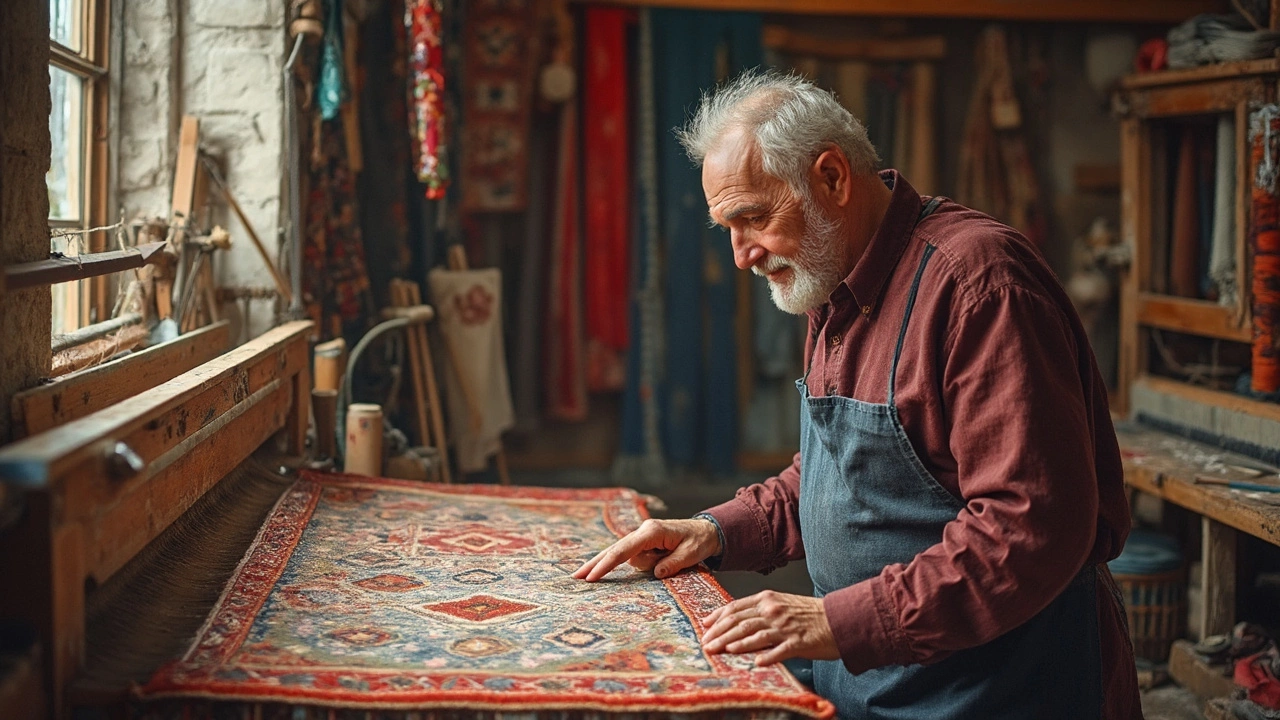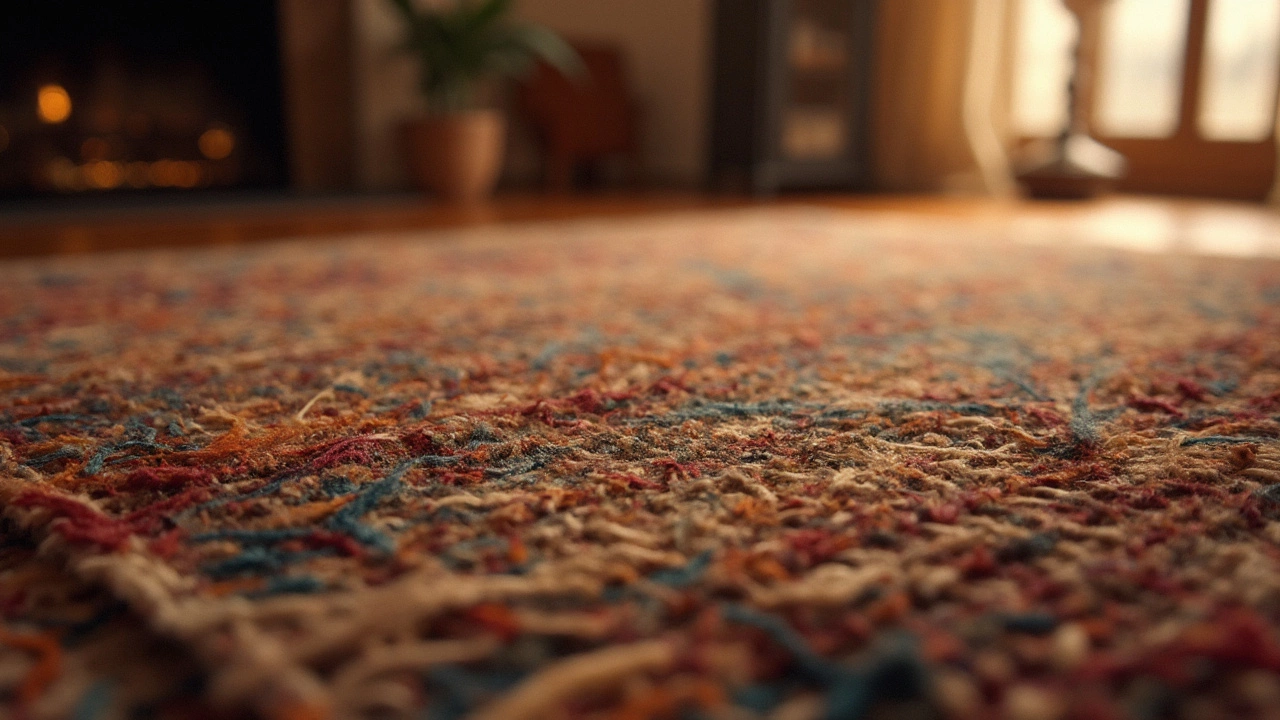When it comes to rugs, most people focus on the colors and patterns of the top side. But flip a rug over, and you'll find a treasure trove of information lurking on the back. Why's that? Well, the back of a rug is like a window into its soul, telling you about quality and craftsmanship that the front can't.
The first thing to look at is the weave. If it's tight and consistent, you've probably got a high-quality rug on your hands. Loose and uneven weaves can indicate something that might not stand up to time or traffic. So next time you're rug shopping, do yourself a favor—go beyond the pretty facade.
And here's another interesting fact: the kind of knots and the loom types can be a giveaway of where the rug was made. It's like rug geography! Knowing if a rug was hand-knotted or made on a machine isn't just fascinating trivia; it impacts value and durability in big ways.
- Why Examining the Back Matters
- Spotting Quality Through Weaving
- Cracking the Code: Knots and Looms
- Maintenance Tips for Longevity
Why Examining the Back Matters
Let's get real for a second. When you're picking a rug, it’s not all about those flashy designs or the colors matching your curtains. The back of the rug is where the real story unfolds. Think of it as flipping a book to its ending before putting all your money on its cover.
First off, checking the back reveals the rug quality. A quick peek can tell you if it’s a hand-knotted gem or a machine-made knockoff. How? Hand-knotted rugs typically have a more complex pattern on the back compared to their machine-made siblings. This is because each knot is tied individually, creating a distinctive look that machines can't quite replicate.
Next, there's the weave to consider. A uniform, tight weave on the back means that rug's gonna withstand the daily grind. Loose and uneven weaves, on the other hand, might not last as long when faced with sneaker-and-pet traffic.
And there's the material. The back can give clues about the rug's materials, whether it's high-quality wool or less durable synthetic fibers. Natural fibers like wool offer more resilience and longevity compared to synthetic materials that can wear down quicker.
- Check for tight, consistent weaves—these signal durability.
- Understand the knot density, with more knots usually indicating a more robust rug.
- Spot hand-knotted details—uneven patterns are a mark of craftsmanship.
Understanding these aspects before purchasing will keep you from regrets later. Plus, aren't you just a bit curious to know what makes your rug tick?
Spotting Quality Through Weaving
When you’re trying to gauge the quality of a rug, the rug back is your best friend. Why? Because the way a rug is woven directly impacts not just how it looks, but how long it lasts. So, let’s dive into what those weaves tell us.
The most important thing to notice is the tightness and evenness of the weave. High-quality rugs often feature tight, consistent weaves. This is vital because it means the fibers are closely packed. This not only feels better underfoot but it's more durable too. A loose weave might look fluffy and cozy at first, but it's likely to wear out faster.
Now, let's talk patterns. On handmade rugs, intricate designs and even shapes on the back scream quality craftsmanship. Machine-made rugs sometimes can’t match this because they often opt for speed over detail.
Keep an eye out for any fraying or gaps on the backside. It may be minor, but it’s a sign that the rug might not handle regular wear and tear very well. Nobody wants a holey rug after just a few years.
Here’s a cool tidbit: some high-end rugs even have a unique identifier woven into the back, thanks to individual weavers. It’s like a painter signing their artwork!
For those into visuals, here's a quick rundown of weaving techniques and their typical quality indicators:
- Hand-knotted: Labor-intensive and usually higher quality. Expect a denser weave.
- Machine-made: Faster, often less expensive. Look for even patterns but check durability.
- Flatweave: No pile, so knots are visible right away. Great for spotting quality directly.
So, next time you're faced with choosing between a couple of rugs, take a moment and look at the back. Deciphering these weaving clues can be the key to picking a rug that not only looks amazing but stands the test of time.

Cracking the Code: Knots and Looms
If you've ever looked closely at a rug back and wondered what all those little bumps and threads mean, you've stumbled upon the fascinating world of knots and looms. Understanding this hidden aspect can make you a savvy rug buyer or owner.
Let's start with knots. In handmade rugs, you'll find two primary types: the Persian or Senneh knot and the Turkish or Ghiordes knot. The Persian knot is asymmetrical, which allows for more intricate designs, while the Turkish knot is symmetrical, providing more durability. You can spot these differences by examining how the threads peek out from the back of the rug.
Now, how about looms? Rugs can be woven on either a handloom or a machine loom. The handloom, where each knot is tied by hand, often means a higher quality, but it also takes longer to make. Machine looms, on the other hand, are quick but may compromise on detail and craftsmanship. You'll often find machine-made rugs will have a more uniform back.
Why should you care? Well, knowing the difference can inform you about a rug's value and authenticity. For instance, a handmade Persian rug with thousands of knots per square inch could be worth a small fortune.
Curious about where your rug might hail from? Check the knots and back texture, and you might just pinpoint its origin. Many Persian rugs have a telltale tight weave and fine knots, while Turkish rugs might use thicker yarns and have a slightly more plush backside.
Now you've got some insights into cracking the code of rug backs. Whether you're buying or maintaining a rug, these details can help you appreciate its story and ensure it enjoys a long life under your care.
Maintenance Tips for Longevity
Keeping your rug looking good and lasting long isn't rocket science, but it does need a bit of regular care. Here's how to make sure your beautiful piece stays in top shape over the years.
First up, rotate your rug every six months. Why? Well, it helps even out wear and tear, especially in high-traffic areas. This simple trick keeps your colors from fading unevenly and prevents excessive damage on one side.
Vacuuming is your rug's best friend. Regular vacuuming removes dirt and particles that can grind away at fibers. Aim to vacuum once a week, but adjust it if your rug is in a busy zone.
Accidents happen, and when they do, be quick with those spills. Blot the area with a clean cloth—don't rub as it could spread the stain. Then, use a mixture of mild detergent and water to spot-clean. Avoid harsh chemicals since they can damage delicate fibers.
- Routine professional cleaning every 12-18 months helps keep your rug in tip-top shape, ensuring deep-seated dirt is removed.
- Use rug pads to prevent slipping and add a bit of cushioning underneath. They help in reducing wear and create a buffer from hard floors.
Keep an eye out for any signs of damage, like fraying edges or loose threads. Catching these early on makes repairs easier and prevents bigger issues down the road.
Finally, be mindful of direct sunlight. It can bleach those vibrant colors. If moving the rug isn't possible, curtains or blinds can help reduce exposure.
These simple steps can go a long way in preserving not just the beauty but also the health of your rug.







